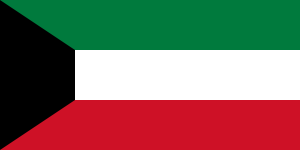As promised, here is the first entry to the country profiles section. The format and headings of the profiles might change overtime depending on what I find works/looks best or depending on what you suggests works better. I tried to include some of the key pieces of information needed to help string together a general overview of the environmental situation in the country. If there are things you feel need to be included let me know and I’ll add it in. Also, WR means World Ranking, just in case you were wondering.
Without further ado, here is Kuwait’s Country Profile.

Kuwait
Population: 2,695,316 (July 2013 est.)*
GDP: $165.9 billion (2012 est.)*
Industrial Production Growth Rate: 8.7% (2011 est.)*
Electricity From Fossil Fuels: 100% of installed capacity (2009 est.)* WR: 20
Crude Oil Production: 2.682 million bbl/day (2011 est.)* WR: 11
Refined Petroleum Products Production: 902,000 bbl/day (2008 est.)* WR: 25
Main Industries:
Oil and Petroleum - Its oil fields were first exploited in the 1930s, and since the development of the petroleum industry after World War II and independence in 1961, oil has dominated the economy, making up around 90% of export revenues.*
Other Key Industries Include: petrochemicals, cement, shipbuilding and repair, water desalination, food processing, construction materials.*
Key Historical Environmental Issues:
1975 Shuaiba Ammonia Plant Evacuation – due to gas leakages causing health problems to residents.
Kuwait’s Oil Well Tragedy of 1991 - As the 1991 Persian Gulf War drew to a close, Iraqi forces set fire to approximately 600 oil wells, which burned for seven months. The Gulf composed of poisonous smoke, soot and ash; experienced black rain; and, lakes of oil were created. Livestock and other animals died with lungs blackened by the liquid (Source: Time Magazine).
Pollution:
According to the Kuwait Allergy Website, some of the main contributors preventing Kuwait from improving their air quality include:
1. The steady increase of vehicles, heavy machinery and factories in a very concentrated area of the country.
2. The fixed residential areas that remain unchanged since the new Kuwait was found and of which have high concentrations of air pollution.
3. Proximity of residential areas with some of the biggest oil fields in the world, and which remain the largest source of pollution and income for the area.
4. Proximity to pollutants from warheads used for ongoing conflict in the surrounding region.
5. Lack of local regulations for inspecting the gases omitted from vehicles, factories, and other sources.
6. Frequent and major malfunctions in the oil refineries and storage.
Effects:
Air Pollution: (Source: Kuwait Allergy Website)
-Short term exposure exacerbates existing pulmonary and cardiovascular disease and increases the need for medical attention, and death.
-Long-term exposure increases the cumulative risk of chronic pulmonary and cardiovascular disease and death.
-The increase of the allergic diseases has occurred in parallel (not in causal relationship) with the increased use of fossil fuels.
Improvements/Solutions:
Kuwait is known to have established and continually improved their EIA (Environmental Impact Assessment System) practises to protect and conserve the environment. EIA is considered one of the foundations that underpin environmental planning to achieve the objectives of State development plans while at the same time ensure the achievement of sustainable development.
Key Environmental Groups:
Environmental Monitoring Information System of Kuwait (eMISK): “is an ambitious system initiated by the Environment Public Authority (EPA) of Kuwait. eMISK aims to establish, build and maintain a comprehensive geo-environmental database of Kuwait… Among the main goals of eMISK are to raise awareness at all levels of Kuwaiti Society of the values of the environment, and to place authoritative scientific information at the center of decision-making”.
Environment Public Authority (EPA) of Kuwait: Their vision is to promote environmental awareness and to create a great behavioural and cultural shift in dealing with the environment in which we live. Their mission is to provide a cultural, scientific message that is concerned with environmental affairs in the State of Kuwait and to document the environment condition in the sea, air and land through a professional teamwork. This teamwork tends to use state-of-the-art instruments in order to form a documented and comprehensive scientific encyclopedia.
Kuwait Environment Protection Society: deals with protecting the environment and eliminating the causes of pollution on both local and regional levels.
*According to the CIA World Factbook
All Sources are Linked Above.
